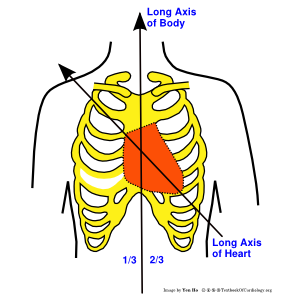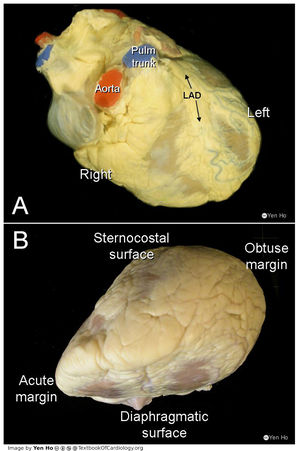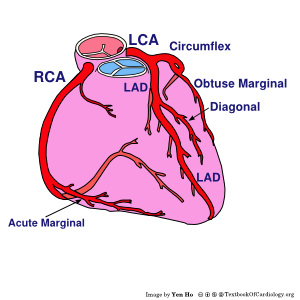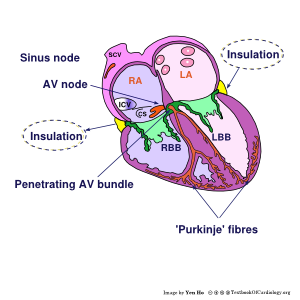Anatomy of the Heart: Difference between revisions
No edit summary |
No edit summary |
||
| (17 intermediate revisions by 3 users not shown) | |||
| Line 2: | Line 2: | ||
The endocast is viewed from 5 different perspectives to demonstrate the spatial relationship between right (coloured blue) and left (coloured red) heart chambers and between atria and ventricles. The blue and white arrows represent the right and left ventricular outflow tracts respectively. | The endocast is viewed from 5 different perspectives to demonstrate the spatial relationship between right (coloured blue) and left (coloured red) heart chambers and between atria and ventricles. The blue and white arrows represent the right and left ventricular outflow tracts respectively. | ||
]] | ]] | ||
<big>Cardiac Anatomy</big> | <big>Cardiac Anatomy</big> | ||
'''S. Yen Ho,''' ''PhD FRCPath FESC FHEA'' | '''S. Yen Ho,''' ''PhD FRCPath FESC FHEA'' | ||
| Line 12: | Line 12: | ||
==Position of the heart== | ==Position of the heart== | ||
[[Image:Figure 2. | [[Image:Figure 2.svg|300px|left|thumb|'''Figure 2.'''<br> | ||
The long axis of the heart is at an angle to the long axis of the body. Approximately a third of the heart is to the right of the midline of the sternum and the remainder is to the left of the midline. | The long axis of the heart is at an angle to the long axis of the body. Approximately a third of the heart is to the right of the midline of the sternum and the remainder is to the left of the midline. | ||
]] | ]] | ||
[[Image:Figure | [[Image:Figure 4.jpg|thumb|300px|right|'''Figure 4.'''<br> | ||
'''A.''' This frontal view shows the right and left surfaces of the heart. The left anterior descending coronary artery buried in epicardial fat marks the plane of the ventricular septum. | |||
<br>'''B.''' The obtuse and acute margins of the ventricles are demonstrated in this apical view.]] | |||
[[Image:Figure 3.svg|thumb|300px|left|'''Figure 3.'''<br> | |||
'''A.''' Viewed from the front, the right atrium and right ventricle overlaps the left atrium and left ventricle. The atrial chambers are to the right of their respective ventricular chambers. | '''A.''' Viewed from the front, the right atrium and right ventricle overlaps the left atrium and left ventricle. The atrial chambers are to the right of their respective ventricular chambers. | ||
<br>'''B.''' The four cardiac valves are at different levels and different planes with the pulmonary(P) valve situated the most cephalad. The aortic(A) valve is wedged between the tricuspid(T) and mitral(M) valves.]] | <br>'''B.''' The four cardiac valves are at different levels and different planes with the pulmonary(P) valve situated the most cephalad. The aortic(A) valve is wedged between the tricuspid(T) and mitral(M) valves.]] | ||
| Line 25: | Line 29: | ||
When the pericardium is removed, the major part of the heart visible from the front is the ventricular mass. Here, the morphologically right ventricle occupies the greater part (Figure 3). The left ventricle appears only as a narrow slip along the left cardiac border. The shape of the heart is generally likened to a pyramid. The apex points downwards, forwards and to the left while the base faces posteriorly and to the right. While the cardiac apex is usually represented by the vortex of the left ventricle, the cardiac base is less well defined owing to differences in definition. | When the pericardium is removed, the major part of the heart visible from the front is the ventricular mass. Here, the morphologically right ventricle occupies the greater part (Figure 3). The left ventricle appears only as a narrow slip along the left cardiac border. The shape of the heart is generally likened to a pyramid. The apex points downwards, forwards and to the left while the base faces posteriorly and to the right. While the cardiac apex is usually represented by the vortex of the left ventricle, the cardiac base is less well defined owing to differences in definition. | ||
The anatomical base is formed mainly by the left atrium receiving the pulmonary veins and to a small extent by the posterior part of the right atrium. The base in clinical practice, however, refers to the portion of the heart near the parasternal parts of the second intercostal spaces. The cardiac long axis, therefore, lies in a line drawn from the left hypochondrium towards the right shoulder. This orientation deviates considerably from the long axis of the body. Furthermore, the position of the cardiac septum at about 45º to the median brings the ‘right heart’ structures anterior to the ‘left heart’ structures (Figure 3A). The ventricles are situated inferior and leftward relative to their corresponding atria. | The anatomical base is formed mainly by the left atrium receiving the pulmonary veins and to a small extent by the posterior part of the right atrium. The base in clinical practice, however, refers to the portion of the heart near the parasternal parts of the second intercostal spaces. The cardiac long axis, therefore, lies in a line drawn from the left hypochondrium towards the right shoulder. This orientation deviates considerably from the long axis of the body. Furthermore, the position of the cardiac septum at about 45º to the median brings the ‘right heart’ structures anterior to the ‘left heart’ structures (Figure 3A). The ventricles are situated inferior and leftward relative to their corresponding atria. | ||
| Line 44: | Line 44: | ||
==The morphologically left atrium== | ==The morphologically left atrium== | ||
[[Image:Figure 6.jpg|thumb|300px| | [[Image:Figure 6.jpg|thumb|300px|right|'''Figure 6.'''<br> | ||
'''A.''' This view from the left-lateral aspect shows the finger-like left atrial appendage with the left atrium situated posteriorly. The left ventricle tapers to a rounded apex. | '''A.''' This view from the left-lateral aspect shows the finger-like left atrial appendage with the left atrium situated posteriorly. The left ventricle tapers to a rounded apex. | ||
<br>'''B.''' This section through the aortic root and mitral valve displays the left atrial aspect of the septum enface. The crescentic edge (arrow) of the fossa valve has not sealed completely resulting in a PFO. The asterisk marks the location of the transverse pericardial sinus.]] | <br>'''B.''' This section through the aortic root and mitral valve displays the left atrial aspect of the septum enface. The crescentic edge (arrow) of the fossa valve has not sealed completely resulting in a PFO. The asterisk marks the location of the transverse pericardial sinus.]] | ||
| Line 51: | Line 51: | ||
==The morphologically right ventricle== | ==The morphologically right ventricle== | ||
[[Image:Figure 7.jpg|thumb|300px| | [[Image:Figure 7.jpg|thumb|300px|left|'''Figure 7.'''<br> | ||
'''A.''' The right ventricle is opened to show the septum and the muscular crest separating tricuspid from pulmonary valves. The moderator band (open arrow) extends from the foot of the septomarginal trabeculation to the free wall of the right ventricle. Coarse trabeculations fill the apical component. | '''A.''' The right ventricle is opened to show the septum and the muscular crest separating tricuspid from pulmonary valves. The moderator band (open arrow) extends from the foot of the septomarginal trabeculation to the free wall of the right ventricle. Coarse trabeculations fill the apical component. | ||
<br>'''B.''' This close-up view of the tricuspid valve at the commissure between septal and antero-septal leaflets shows the annulus (broken line) crossing the membranous septum (dots) dividing it into atrioventricular(av) and interventricular(iv) components.]] | <br>'''B.''' This close-up view of the tricuspid valve at the commissure between septal and antero-septal leaflets shows the annulus (broken line) crossing the membranous septum (dots) dividing it into atrioventricular(av) and interventricular(iv) components.]] | ||
| Line 58: | Line 58: | ||
==The morphologically left ventricle== | ==The morphologically left ventricle== | ||
[[Image:Figure 8.jpg|thumb|300px|right| | [[Image:Figure 8.jpg|thumb|300px|right|'''Figure 8.'''<br> | ||
'''A.''' The left ventricle is opened through its outflow tract into the aortic valve. The aortic valve leaflets are in fibrous continuity with the anterior leaflet of the mitral valve. The fibrous continuity is expanded at the right and left fibrous trigones. The right trigone(asterisk) is the landmark for the atrioventricular conduction bundle. Note how the thickness of the left ventricular wall diminishes remarkably at the apex (open arrow). | '''A.''' The left ventricle is opened through its outflow tract into the aortic valve. The aortic valve leaflets are in fibrous continuity with the anterior leaflet of the mitral valve. The fibrous continuity is expanded at the right and left fibrous trigones. The right trigone(asterisk) is the landmark for the atrioventricular conduction bundle. Note how the thickness of the left ventricular wall diminishes remarkably at the apex (open arrow). | ||
<br>'''B.''' This dissection shows the central location of the aortic valve. L, N and R are the left-coronary, non-coronary and right-coronary aortic sinuses respectively.]] | <br>'''B.''' This dissection shows the central location of the aortic valve. L, N and R are the left-coronary, non-coronary and right-coronary aortic sinuses respectively.]] | ||
| Line 79: | Line 79: | ||
==The coronary circulation== | ==The coronary circulation== | ||
[[Image:Figure 9. | [[Image:Figure 9.svg|thumb|300px|right|'''Figure 9.'''<br> | ||
Diagram showing the right (RCA) and left (LCA) coronary arteries and their main ventricular branches. The left anterior descending (LAD) and posterior descending (PDA) coronary arteries mark the anterior and posterior margins of the ventricular septum.]] | |||
As mentioned previously, the left and right coronary arteries emerge from the left and right coronary sinuses respectively. Usually the arteries arise from within the sinus just beneath or at the level of the aortic bar (sinutubular junction). In the left sinus there is usually a single orifice but in the right sinus it is usual to find multiple orifices where the early branches of the right coronary artery take direct origin. The main coronary arteries pass within the fatty tissues of the atrioventricular and interventricular grooves. The left coronary has a short main stem that branches into the anterior descending and circumflex arteries (Figure 9). The circumflex runs in the left atrioventricular groove and the right coronary artery runs in the right atrioventricular groove to variable lengths. From the atrioventricular groove, the encircling arteries give origin to ventricular and atrial branches. An early atrial branch is the sinus node artery which arises slightly more frequently from the right than the left coronary artery. It usually ascends the interatrial musculature to reach the terminal groove but recent evidence has shown a more variable course. In the majority of hearts the posterior descending artery, which runs in the posterior interventricular groove, is a branch from the right coronary artery and this is termed 'right dominance'. In a little under 10% of hearts the posterior descending is a branch of the circumflex giving 'left dominance'. A 'balanced' circulation is seen when both right and left coronary arteries give rise to parallel posterior descending branches. The artery to the atrioventricular node arises from the dominant artery at the cardiac crux. | As mentioned previously, the left and right coronary arteries emerge from the left and right coronary sinuses respectively. Usually the arteries arise from within the sinus just beneath or at the level of the aortic bar (sinutubular junction). In the left sinus there is usually a single orifice but in the right sinus it is usual to find multiple orifices where the early branches of the right coronary artery take direct origin. The main coronary arteries pass within the fatty tissues of the atrioventricular and interventricular grooves. The left coronary has a short main stem that branches into the anterior descending and circumflex arteries (Figure 9). The circumflex runs in the left atrioventricular groove and the right coronary artery runs in the right atrioventricular groove to variable lengths. From the atrioventricular groove, the encircling arteries give origin to ventricular and atrial branches. An early atrial branch is the sinus node artery which arises slightly more frequently from the right than the left coronary artery. It usually ascends the interatrial musculature to reach the terminal groove but recent evidence has shown a more variable course. In the majority of hearts the posterior descending artery, which runs in the posterior interventricular groove, is a branch from the right coronary artery and this is termed 'right dominance'. In a little under 10% of hearts the posterior descending is a branch of the circumflex giving 'left dominance'. A 'balanced' circulation is seen when both right and left coronary arteries give rise to parallel posterior descending branches. The artery to the atrioventricular node arises from the dominant artery at the cardiac crux. | ||
| Line 86: | Line 87: | ||
==The cardiac conduction system== | ==The cardiac conduction system== | ||
[[Image:Figure 10. | [[Image:Figure 10.svg|thumb|300px|right|'''Figure 10.'''<br> | ||
The cardiac conduction system. Normally, the insulating fibro-fatty tissue plane at the atrioventricular junction prevents atrial myocardium from contacting ventricular myocardium. The penetrating bundle is the only muscular bridge.]] | |||
The full complement of the histologically specialised tissues making the conduction system of the heart comprises the sinus node and the atrioventricular system (Figure 10). The latter is made up of the atrioventricular node, the penetrating atrioventricular bundle and the ventricular bundle branches. The geometry of the right atrium is such that it is made up of bands of muscle which separate the orifices of the great veins and the oval fossa. The spread of excitation from the sinus to the atrioventricular node has been shown to spread preferentially along these broad bands of ordinary atrial myocardium. | The full complement of the histologically specialised tissues making the conduction system of the heart comprises the sinus node and the atrioventricular system (Figure 10). The latter is made up of the atrioventricular node, the penetrating atrioventricular bundle and the ventricular bundle branches. The geometry of the right atrium is such that it is made up of bands of muscle which separate the orifices of the great veins and the oval fossa. The spread of excitation from the sinus to the atrioventricular node has been shown to spread preferentially along these broad bands of ordinary atrial myocardium. | ||
==The sinus node== | ==The sinus node== | ||
[[Image:Figure 11.jpg|thumb| | [[Image:Figure 11.jpg|thumb|left|300px|'''Figure 11.'''<br> | ||
'''A.''' The sinus node (dotted shape) is superimposed onto the terminal groove in this picture of the right atrium viewed from the right side. The arrows indicate the sectioning plane of the histological section shown in B. | |||
<br>'''B.''' This section from an infant heart is stained in Masson’s trichrome stain that colours myocardium red and fibrous tissue blue. The sinus node is readily identifiable by its composition of small myocytes in a fibrous matrix.]] | <br>'''B.''' This section from an infant heart is stained in Masson’s trichrome stain that colours myocardium red and fibrous tissue blue. The sinus node is readily identifiable by its composition of small myocytes in a fibrous matrix.]] | ||
| Line 98: | Line 101: | ||
==The atrioventricular conduction system== | ==The atrioventricular conduction system== | ||
[[Image:Figure 12.jpg|thumb|300px| | [[Image:Figure 12.jpg|thumb|300px|left|'''Figure 12.'''<br> | ||
'''A.''' This view of the right atrium and right ventricle shows the anterior and posterior borders of the triangle of Koch (broken lines) that mark location of the atrioventricular node and bundle (orange shapes). The arrows B, C, D indicate the cuts made through the conduction system as shown on the histologic sections. | |||
<br>'''B''', '''C''' and '''D''' are step sections stained with Masson’s trichrome technique and displayed in similar orientation tracing the atrioventicular conduction system from the AV node (AVN) that adjoins the central fibrous body (cfb), to the penetrating His bundle (H), and the branching bundle (BB) dividing into the left (LBB) and right (RBB) bundle branches.]] | <br>'''B''', '''C''' and '''D''' are step sections stained with Masson’s trichrome technique and displayed in similar orientation tracing the atrioventicular conduction system from the AV node (AVN) that adjoins the central fibrous body (cfb), to the penetrating His bundle (H), and the branching bundle (BB) dividing into the left (LBB) and right (RBB) bundle branches.]] | ||
[[Image:Figure 13.jpg|thumb|300px|right|This picture from Tawara’s monograph (1906) shows the tree-fascicular arrangement of the left bundle branch in man. | [[Image:Figure 13.jpg|thumb|300px|right|'''Figure 13.'''<br> | ||
This picture from Tawara’s monograph (1906) shows the tree-fascicular arrangement of the left bundle branch in man. | |||
(Tawara S 1906 Das Reizleitungssystem des Säugetierherzens. Eine Anatomisch-Histologische Studie Über das Atrioventrikularbündel und die Purkinjeschen Fäden. Gustav Fischer, Jena.)]] | (Tawara S 1906 Das Reizleitungssystem des Säugetierherzens. Eine Anatomisch-Histologische Studie Über das Atrioventrikularbündel und die Purkinjeschen Fäden. Gustav Fischer, Jena.)]] | ||
| Line 117: | Line 122: | ||
<biblio> | <biblio> | ||
#Wenckebach Wenckebach KF. ''Beiträge zur Kenntnis der menschlichen Herztätigkeit.'' Arch Anat Physiol l907; 2:1. | #Wenckebach Wenckebach KF. ''Beiträge zur Kenntnis der menschlichen Herztätigkeit.'' Arch Anat Physiol l907; 2:1. | ||
# | #Keith1907 pmid=17232727 | ||
#Lewis Lewis T. Oppenheimer BS, Oppenheimer A. ''Site of origin of the mammalian heart beat: the pacemaker in the dog.'' Heart 1910;2:147 | #Lewis Lewis T. Oppenheimer BS, Oppenheimer A. ''Site of origin of the mammalian heart beat: the pacemaker in the dog.'' Heart 1910;2:147 | ||
#HisW His W Jr. ''Die Thatigkeit des embryonalen Herzens und deren Bedeutung für die Lehre von Herzbewegung beim Erwachsenen.'' Ar Med Klin Leip 1893:14. | #HisW His W Jr. ''Die Thatigkeit des embryonalen Herzens und deren Bedeutung für die Lehre von Herzbewegung beim Erwachsenen.'' Ar Med Klin Leip 1893:14. | ||
#Tawara Tawara S. ''Das Reizleitungssystem des Saugetierherzen.'' Gustav Fischer, Jena. 1906 | #Tawara Tawara S. ''Das Reizleitungssystem des Saugetierherzen.'' Gustav Fischer, Jena. 1906 | ||
#Purkinje Purkinje JE. ''Mikroskopisch neurologische Beobachtungen.'' Archiv Anat Physiol u Wiss Med I845;12:28I. | #Purkinje Purkinje JE. ''Mikroskopisch neurologische Beobachtungen.'' Archiv Anat Physiol u Wiss Med I845;12:28I. | ||
# | #Flack1906 pmid=15485521 | ||
#Koch Koch W. ''Der funktionelle Bau des menschlichen Herzens.'' Berlin: Urban v Schwarzenburg,1922:92. | #Koch Koch W. ''Der funktionelle Bau des menschlichen Herzens.'' Berlin: Urban v Schwarzenburg,1922:92. | ||
#Rosenbaum Rosenbaum MB, Elizari MV, Lazzari JO. ''The hemiblocks.'' In: Tampa Tracings. Oldsmar, Fla. 1970. | #Rosenbaum Rosenbaum MB, Elizari MV, Lazzari JO. ''The hemiblocks.'' In: Tampa Tracings. Oldsmar, Fla. 1970. | ||
</biblio> | </biblio> | ||
|} | |} | ||
Latest revision as of 22:28, 11 January 2021

The endocast is viewed from 5 different perspectives to demonstrate the spatial relationship between right (coloured blue) and left (coloured red) heart chambers and between atria and ventricles. The blue and white arrows represent the right and left ventricular outflow tracts respectively.
Cardiac Anatomy S. Yen Ho, PhD FRCPath FESC FHEA Royal Brompton Hospital
Traditionally, the heart is described as having left heart and right heart chambers. Current imaging techniques can show in exquisite detail the heart in its anatomical position inside the living patient’s chest and demonstrate the convoluted arrangement of ‘right’ heart chambers relative to ‘left’ heart chambers and the fact that right heart chambers are not strictly right-sided nor are left heart chambers left-sided. These important relationships of the chambers can be replicated with an endocast (Figure 1). In cardiac anatomy, knowledge of the relative disposition of the cardiac chambers is as relevant as the intrinsic chamber morphology. This review considers the cardiac chambers, coronary arteries and the conduction system.
Position of the heart
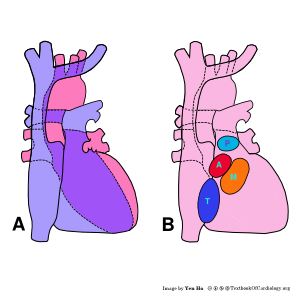
A. Viewed from the front, the right atrium and right ventricle overlaps the left atrium and left ventricle. The atrial chambers are to the right of their respective ventricular chambers.
B. The four cardiac valves are at different levels and different planes with the pulmonary(P) valve situated the most cephalad. The aortic(A) valve is wedged between the tricuspid(T) and mitral(M) valves.
The cardiac silhouette is generally taken to be trapezoidal in shape. The rib cage provides good markers for charting the cardiac silhouette. The normal position of the cardiac apex is generally taken to be in the fifth intercostal space in the mid-clavicular line. The lower border is a nearly horizontal line in the area of the left sixth rib to the right sixth costal cartilage (Figure 2). The upper border is hidden behind the sternum at the level of the second and third cartilages. The right margin of the heart peeps out behind the right border of the sternum between the right third and sixth cartilages. In the infant, the upper part of the cardiac shadow is broad owing to the prominence of the overlying thymus gland.
Inferior to the thymus, a fibrous pericardial sac encloses the mass of the heart. The sac has cuff-like attachments around the adventitia of the great arteries and veins as they enter or emerge from the heart. The pericardial cavity is contained between the double-layered serous pericardium. The parietal pericardium is adherent to the fibrous pericardium while the visceral layer is densely adherent to the cardiac surface forming the epicardium. Due to the contours of the heart and great arteries there exist two recesses within the pericardial cavity. These are the transverse and oblique sinuses. The transverse sinus occupies the inner heart curvature and lies between the posterior surface of the great arteries and the anterior surface of the atrial chambers. The reflection of the serous pericardium around the four pulmonary veins and the inferior caval vein forms the oblique sinus.
When the pericardium is removed, the major part of the heart visible from the front is the ventricular mass. Here, the morphologically right ventricle occupies the greater part (Figure 3). The left ventricle appears only as a narrow slip along the left cardiac border. The shape of the heart is generally likened to a pyramid. The apex points downwards, forwards and to the left while the base faces posteriorly and to the right. While the cardiac apex is usually represented by the vortex of the left ventricle, the cardiac base is less well defined owing to differences in definition.
The anatomical base is formed mainly by the left atrium receiving the pulmonary veins and to a small extent by the posterior part of the right atrium. The base in clinical practice, however, refers to the portion of the heart near the parasternal parts of the second intercostal spaces. The cardiac long axis, therefore, lies in a line drawn from the left hypochondrium towards the right shoulder. This orientation deviates considerably from the long axis of the body. Furthermore, the position of the cardiac septum at about 45º to the median brings the ‘right heart’ structures anterior to the ‘left heart’ structures (Figure 3A). The ventricles are situated inferior and leftward relative to their corresponding atria.
This results in the right atrioventricular junction being in a nearly vertical plane. The left atrium is the most posterior cardiac chamber being directly anterior to the oesophagus at the bifurcation of the trachea. In frontal projection, only its appendage is visible. The aorta has a deep-seated origin and only becomes part of the cardiac silhouette as it arches upwards and backwards, forming a spiral with the pulmonary trunk. The cardiac valves are offset from one another, in keeping with the disposition of the cardiac chambers and great arteries. When viewed in frontal projection, the pulmonary valve, being the most superior valve, is horizontally situated behind the third costal cartilage. The aortic valve lies posterior and to the right, above the nearly vertically orientated tricuspid valve (Figure 3B). The mitral valve is further posterior, overlapped by the more anterior but inferior tricuspid valve. The aortic valve therefore occupies a central position in the heart, wedged between the two atrioventricular valves.
The cardiac surfaces are described as the sternocostal, diaphragmatic, left and right (Figure 4). The sternocostal surface is covered anteriorly by the sternum and pleurae. The diaphragmatic surface is horizontally orientated. The sharp angle formed mainly by the right ventricle and occupying the lower heart border is the acute margin of the heart. The rounded obtuse margin of the heart is formed mainly by the left ventricle to the left of the sternocostal surface.
The morphologically right atrium
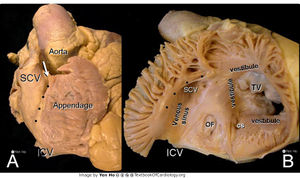
A. This right lateral view shows the right atrium dominated by its large, triangluar shaped appendage. The dots mark the terminal groove. The arrow indicates the crest of the appendage.
B. The lateral wall of the appendage incised and flipped backward to show the pectinate muscles and the thin, membrane-like atrial wall between the muscle bundles. The terminal crest (dots) marks the border between the pectinated appendage and the smooth-walled venous sinus. The oval fossa is surrounded by its muscular rim. The smooth-walled vestibule leads to the tricuspid valve orifice.
The right atrium is composed of an anterior appendage, a posterior venous sinus, a septal portion and a vestibule. The junction between the appendage and the venous sinus is marked epicardially by an atrial groove the terminal groove, in which lies the sinus node. Inside the chamber, the terminal groove is represented by a muscle bundle, the terminal crest (crista terminalis), from which pectinate muscles radiate into the appendage (Figure 5). The appendage has a characteristic triangular shape and a wide communication with the venous sinus. The smooth-walled venous sinus receives the superior and inferior caval veins in its cephalic and caudal extremities respectively. The coronary sinus opens close to the septal portion and near the opening of the inferior caval vein. The outlet portion of the atrium, the vestibule leading to the tricuspid valve orifice, is also smooth walled. The obliquely orientated atrial septum extends from right posterior to left anterior position. When viewed from the right atrial aspect, the atrial septum is characterised by a muscular rim – the limbus - which surrounds the flap valve of the oval fossa (Figure 5). The extent of the true septum, however, is limited to the flap valve and the immediate part of its surrounding muscular rim. On the epicardial side much of the rim is filled by the interatrial groove which separates the right atrium from the right pulmonary veins posteriorly and superiorly. In its anterior part, the infolded rim contains the continuation of the interatrial groove and its musculature extends to the anterior wall of the right atrium, directly related to the transverse pericardial sinus. Only a small portion of the inferior rim is part of the true atrial septum. Its major portion is the continuation of the right atrial wall, the vestibule, overlying the crest of the ventricular septum (Figure 5). In fetal life, the flap valve of the oval fossa allows venous return mostly from the inferior caval vein to enter the left atrium. After birth the valve is normally large enough to close the interatrial communication as higher left atrial pressure pushes the valve against the muscular rim forming a complete seal. A probe patency (a probe could be passed from right to left atrium through an unsealed antero-superior part of the rim) exists in about a quarter of the normal population and is generally referred to as a PFO.
The morphologically left atrium
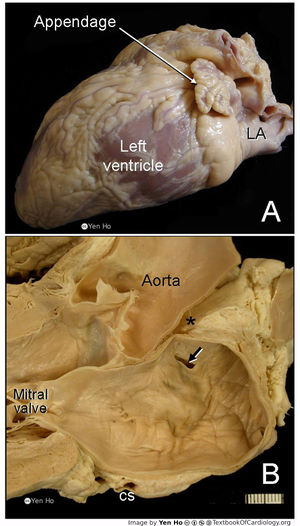
A. This view from the left-lateral aspect shows the finger-like left atrial appendage with the left atrium situated posteriorly. The left ventricle tapers to a rounded apex.
B. This section through the aortic root and mitral valve displays the left atrial aspect of the septum enface. The crescentic edge (arrow) of the fossa valve has not sealed completely resulting in a PFO. The asterisk marks the location of the transverse pericardial sinus.
The left atrium also has a venous component, a characteristic appendage, a septal component and a vestibule that leads to the mitral orifice. Other than the appendage, the main chamber of the left atrium is relatively smooth-walled. The appendage is hook-shaped with a crenelated external appearance and a narrow junction with the venous component (Figure 6). The junction is not marked by any structure comparable to the terminal crest although in many hearts there is a prominent infolding of the atrial wall between the orifice of the atrial appendage and the orifices of the left pulmonary veins. The venous portion is anchored by the pulmonary veins which drain directly into its superior and posterior parts. There are usually four pulmonary venous orifices but variations are not uncommon. The coronary sinus runs inferiorly behind the posterior wall to open into the right atrium. The flap valve of the oval fossa on the septal aspect has a small crescent marking the free edge of the valve at the fossa opening (the site of the PFO) whereas the rest of the valve blends into the atrial wall (Figure 6).
The morphologically right ventricle
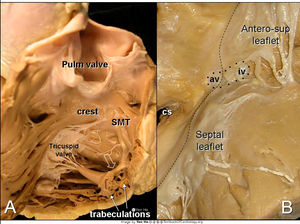
A. The right ventricle is opened to show the septum and the muscular crest separating tricuspid from pulmonary valves. The moderator band (open arrow) extends from the foot of the septomarginal trabeculation to the free wall of the right ventricle. Coarse trabeculations fill the apical component.
B. This close-up view of the tricuspid valve at the commissure between septal and antero-septal leaflets shows the annulus (broken line) crossing the membranous septum (dots) dividing it into atrioventricular(av) and interventricular(iv) components.
Description of the ventricular chambers is facilitated by considering them in terms of three components - inlet, apical trabecular and outlet. The inlet contains the atrioventricular valve and its tension apparatus; the outlet supports the arterial valve. The apical trabecular portion is the most distinctive in each ventricle being characteristically coarse in the right ventricle (Figure 7A) and fine in the left ventricle. In a similar way, the muscular ventricular septum can be considered in terms of inlet, apical trabecular and outlet portions. A small fibrous area, the membranous septum, is located at this tripartite junction. The attachment of the septal tricuspid valve leaflet divides the membranous septum into atrioventricular and interventricular components (Figure 7B). It is important to appreciate that the entire ventricular septum is not on one plane. Owing to the 'wrap-around' relationship of the right ventricle to the left ventricle, the various portions are arranged at angles to each other. The inlet septum (between the ventricular inlet portions) is more or less at the sagittal plane of the body. Extending out apically and curving between the inlet and outlet components is the trabecular septum. In lateral projection, the right ventricle is seen to sweep from beneath to above the left ventricle. When viewed in frontal projection the right ventricle passes in front of the left ventricle (Figure 1). A prominent Y-shaped muscle band, the septomarginal trabeculation, is adherent onto the septal surface. Clasped in between the limbs of the septomarginal trabeculation is the supraventricular crest, a distinctive feature of the right ventricle. The tricuspid valve is separated from the pulmonary valve by this crest (Figure 7A). Much of the crest is simply the infolded inner heart curvature with fatty tissue containing the right coronary artery on its epicardial aspect. The body of the septomarginaI trabeculation gives origin to the moderator band that crosses the ventricular cavity to insert to the anterior wall. The right ventricular inlet component extends from the tricuspid valve orifice to the attachment of the papillary muscle but a discrete demarcation is not seen. The tricuspid valve lacks a well-formed fibrous annulus. Its three leaflets are not always easy to identify owing to clefts within its major leaflets. The commissural chords will identify the divisions between the three leafets - the antero-superior, the septal and the postero-inferior. The direct attachment of the septal leaflet to the septum is a distinguishing feature of the tricuspid valve.
The morphologically left ventricle
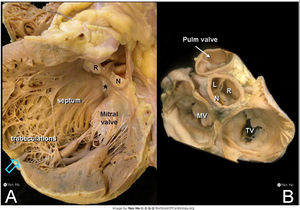
A. The left ventricle is opened through its outflow tract into the aortic valve. The aortic valve leaflets are in fibrous continuity with the anterior leaflet of the mitral valve. The fibrous continuity is expanded at the right and left fibrous trigones. The right trigone(asterisk) is the landmark for the atrioventricular conduction bundle. Note how the thickness of the left ventricular wall diminishes remarkably at the apex (open arrow).
B. This dissection shows the central location of the aortic valve. L, N and R are the left-coronary, non-coronary and right-coronary aortic sinuses respectively.
In contrast to the right ventricle, the left ventricle is a conical structure with thick tubular walls tapering to a rounded apex (Figure 6A) where the apical wall becomes as thin as 1-2 mm. Very little of the left ventricle is visible from the front of the heart (Figures 1 and 3A) although in the infant a relatively greater portion may be seen. As with the right ventricle, the left ventricle comprises inlet, trabecular and outlet portions. The acute angle between inlet and outlet portions brings the aortic valve in adjacency and in fibrous continuity with the mitral valve. There is no structure comparable to the supraventricular crest in the left ventricle. There is also no structure corresponding to the septomarginal trabeculation on the smooth septal surface (Figure 8A).
The inlet component surrounds and contains the mitral valve and its tension apparatus. The outlet component supports the aortic valve but only half its circumference is muscular while the other half is an area of fibrous continuity between aortic and mitral valves. The aortic (antero-superior) leaflet of the mitral valve is suspended like a curtain between the inlet and outlet components. The deeply wedged posterior position of the aortic outflow tract displaces the mitral valve leaflets away from the septum as contrasted with the septal attachment of the tricuspid valve. The trabecular component has characteristically fine trabeculations (Figure 8A).
The mitral valve annulus is thickened at each commissure to form the left and right fibrous trigones. The annular attachment of the aortic (or anterior) leaflet is related to the membranous septum and right fibrous trigone (together making the central fibrous body). The other leaflet of the mitral valve - the mural (or posterior) leaflet - usually has three scallops. The mitral valve is supported by two groups of papillary muscles in antero-lateral and postero-medial positions. Although textbook pictures tend to portray the papillary muscles as arranged far apart, they are in reality situated close to one another. Each papillary muscle supports the adjacent part of both leaflets and the commissures are marked by fan-shaped commissural chords. The outlet component supports the aortic valve. The semilunar leaflets are attached within the expanded aortic sinuses (of Valsalva). The sinuses are not strictly in right and left position although they are so designated in consideration of the origins of the coronary arteries. The central position of the aorta places it in close relation to each of the cardiac chambers and valves (Figure 8B).
The commissure between right and left coronary cusps is usually positioned opposite a commissure of the pulmonary valve. The commissure between the left and non-coronary leaflets points towards the left atrium. The commissure between right coronary and non-coronary leaflets lies above the membranous septum and is closely related to the right atrium and right ventricle and the atrioventricular conduction bundle (Figure 8B).
The aorta
The ascending aorta arises in right posterior position relative to the pulmonary trunk (Figure 1, upper panel). It ascends superiorly, obliquely to the right and slightly anterior toward the sternum. On the right is the medial wall of the right atrium. Anteriorly are the right atrial appendage, the right ventricular outflow tract and the pulmonary trunk. The transverse pericardial sinus separates the back of the aorta from the left atrium and right pulmonary artery. The arch of the aorta begins just above the cuff of pericardial reflection, proximal to the origin of the brachiocephalic artery. The arch passes superiorly for a short distance before passing posteriorly to the left and finally terminating on the lateral aspect of the vertebral column. In its course, the arch gives origin to the neck and arm arteries. The arterial duct, a patent channel in fetal life, connects the left pulmonary artery to the aorta just distal to the origin of the left subclavian artery. In the adult, the duct is represented by a fibrous ligament.
The pulmonary arteries
The pulmonary trunk is also covered with a cuff of serous pericardium at its origin. It arises from the anterior aspect of the heart, just behind the left lateral edge of the sternum. It swings diagonally to the left side of the ascending aorta (Figure 1, upper panel). Being a short vessel, it soon bifurcates into the left and right pulmonary arteries. The left pulmonary artery passes in front of the descending aorta and superior to the left main bronchus before branching in the lung hilum. The longer right pulmonary artery traverses the mediastinum under the aortic arch before passing behind the superior caval vein to reach the right lung hilum.
The coronary circulation
As mentioned previously, the left and right coronary arteries emerge from the left and right coronary sinuses respectively. Usually the arteries arise from within the sinus just beneath or at the level of the aortic bar (sinutubular junction). In the left sinus there is usually a single orifice but in the right sinus it is usual to find multiple orifices where the early branches of the right coronary artery take direct origin. The main coronary arteries pass within the fatty tissues of the atrioventricular and interventricular grooves. The left coronary has a short main stem that branches into the anterior descending and circumflex arteries (Figure 9). The circumflex runs in the left atrioventricular groove and the right coronary artery runs in the right atrioventricular groove to variable lengths. From the atrioventricular groove, the encircling arteries give origin to ventricular and atrial branches. An early atrial branch is the sinus node artery which arises slightly more frequently from the right than the left coronary artery. It usually ascends the interatrial musculature to reach the terminal groove but recent evidence has shown a more variable course. In the majority of hearts the posterior descending artery, which runs in the posterior interventricular groove, is a branch from the right coronary artery and this is termed 'right dominance'. In a little under 10% of hearts the posterior descending is a branch of the circumflex giving 'left dominance'. A 'balanced' circulation is seen when both right and left coronary arteries give rise to parallel posterior descending branches. The artery to the atrioventricular node arises from the dominant artery at the cardiac crux.
After passing through the capillary network, coronary arterial blood is collected by venules which drain to the cardiac veins. The veins drain either to the coronary sinus or directly to the cardiac chambers. The great cardiac vein ascends along the anterior descending coronary and turns into the left atrioventricular groove. In the posterior atrioventricular groove it becomes the coronary sinus. It is joined near its entrance to the right atrium by the middle cardiac vein which ascends in the posterior interventricular groove and the small cardiac vein. The latter ascends along the marginal coronary artery before entering the posterior atrioventricular groove. Atrial veins also empty into the coronary sinus. A further group of veins, the anterior cardiac veins, run across the anterior aspect of the heart to drain directly into the right atrium. In addition to the coronary arteries and veins, the heart also has an extensive lymphatic network. These are divided into the deep, middle and superficial plexuses which drain into collecting channels accompanying the major arterial stems and finally into primary lymph nodes situated in the anterior mediastinum.
The cardiac conduction system
The full complement of the histologically specialised tissues making the conduction system of the heart comprises the sinus node and the atrioventricular system (Figure 10). The latter is made up of the atrioventricular node, the penetrating atrioventricular bundle and the ventricular bundle branches. The geometry of the right atrium is such that it is made up of bands of muscle which separate the orifices of the great veins and the oval fossa. The spread of excitation from the sinus to the atrioventricular node has been shown to spread preferentially along these broad bands of ordinary atrial myocardium.
The sinus node
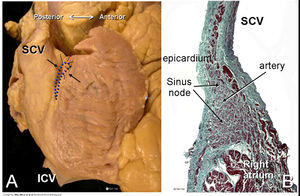
A. The sinus node (dotted shape) is superimposed onto the terminal groove in this picture of the right atrium viewed from the right side. The arrows indicate the sectioning plane of the histological section shown in B.
B. This section from an infant heart is stained in Masson’s trichrome stain that colours myocardium red and fibrous tissue blue. The sinus node is readily identifiable by its composition of small myocytes in a fibrous matrix.
The 'ultimum moriens', the last part of the heart to stop beating when the organ is isolated from the body, first prompted Wenckebach to believe that this may also be the seat of the heart beat.[1] The discovery of the sinus node in the heart of a mole culminated in a paper in 1907 in which Keith and Flack described 'a remarkable remnant of primitive fibres persisting at the sino•auricular junction in all mammalian hearts. These fibres are in close connection with the vagus and sympathetic nerves, and have a special arterial blood supply; in them the dominating rhythm of the heart is believed to normally arise'.[2] The subsequent elegant combined anatomico-physiological studies of Lewis and the Oppenheimers in 1910 confirmed the pacemaking role of the sinus node.[3] The sinus node predominantly occupies an antero-lateral location of the superior cavo-atrial junction within the terminal groove (Figure 11A). Only occasionally it is horseshoe-shaped draping over the right atrial summit. In most adult hearts it is shaped like a tadpole measuring about 3mm in diameter at its widest part and 15 to 20mm in length. A tapering 'tail' of the node may be traced from the epicardium to pass intramyocardially toward the inferior part of the terminal crest. The sinus node is easily recognised by the light microscope at low magnification. It is made up of small cells grouped together in interconnecting fascicles set in a fibrous tissue matrix (Figure 11B). The fibrous matrix becomes more prominent with increasing age. At the margins of the node is a short transitional area where nodal cells merge into atrial myocardium. In places, discrete tongues of transitional cells are found which extend into the terminal crest and toward the myocardial sleeve of the superior caval vein. The blood supply to the node shows considerable variation. A main artery penetrating the length of the node is seen in some hearts. In others, the nodal substance is penetrated by ramifications of an artery approaching the node through one or both ends, there being variations in nodal approaches. Even the origin of the sinus node artery is diverse, arising from the right or left coronary artery at different locations. Collections of ganglion cells are usually observed in the epicardium and also in the environs of the sinus node.
The atrioventricular conduction system
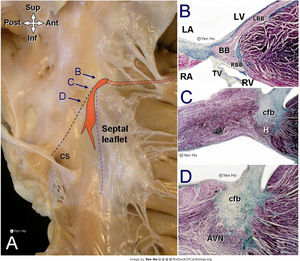
A. This view of the right atrium and right ventricle shows the anterior and posterior borders of the triangle of Koch (broken lines) that mark location of the atrioventricular node and bundle (orange shapes). The arrows B, C, D indicate the cuts made through the conduction system as shown on the histologic sections.
B, C and D are step sections stained with Masson’s trichrome technique and displayed in similar orientation tracing the atrioventicular conduction system from the AV node (AVN) that adjoins the central fibrous body (cfb), to the penetrating His bundle (H), and the branching bundle (BB) dividing into the left (LBB) and right (RBB) bundle branches.
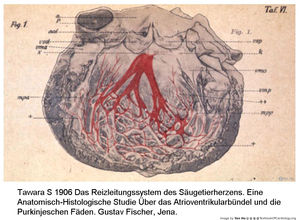
This picture from Tawara’s monograph (1906) shows the tree-fascicular arrangement of the left bundle branch in man. (Tawara S 1906 Das Reizleitungssystem des Säugetierherzens. Eine Anatomisch-Histologische Studie Über das Atrioventrikularbündel und die Purkinjeschen Fäden. Gustav Fischer, Jena.)
Occasional reference to this as the system of His-Tawara gives credit to two of the pioneering investigators in this field. The myocardial bridge that connects atrial myocardium to ventricular myocardium across the insulating fibro-fatty tissues of the atrioventricular junction was found by His in 1893 and given the appellation ‘penetrating bundle of His’.[4] Tawara's monograph[5] accompanied by colour plates in 1906 gave a detailed description of the atrioventricular node and how it was a continuum with the bundle described by His and the ventricular fibres previously described by Purkinje.[6] This firmly estabIished the presence of an atrioventricular conduction system (Figure 10) and was subsequently confirmed by Keith and Flack in the same year.[7] Gross anatomical landmarks to the location of the atrioventricular system are invaluable guides to cardiac surgeons and interventionists who have to perform intracardiac procedures since trauma to any part of the system can produce dire complications.
The atrioventricular node is located at the apex of an angle formed by the tendinous continuation of the Eustachian valve (tendon of Todaro) and the annular insertion of the septal leaflet of the tricuspid valve (Figure 12). The coronary sinus completes the base of the triangular shape which bears the name 'triangle of Koch' in recognition of Koch's elegant descriptions.[8] The tendon of Todaro inserts into the central fibrous body. In the adult the atrioventricular node measures about 4 mm in width and 8 mm in length. In histological sections the compact part of the node is easily recognisable being composed of interconnecting fascicles of small cells, closely adherent to the central fibrous body. In cross•section the node appears like a haIf-oval lying against the fibrous body (Figure 12D). A transitional zone of attenuated myocardial cells extends into the atrial myocardium. The node becomes the penetrating bundle as the conduction system passes through the central fibrous body (Figure 12C).
The penetrating bundle veers to the left as it continues into the branching bundle to emerge in the left ventricle beneath the commissure that separates the right-coronary and non-coronary aortic valve leaflets. The bifurcation into left and right bundle branches marks the beginning of the branching bundle (Figure 12B). The right bundle branch is cord-like and frequently is the continuation of the nodal-bundle axis. It turns downwards and passes intramyocardially into the substance of the septomarginal trabeculation directly beneath the medial papillary muscle complex. It then passes subendocardially towards the right ventricular apex and crosses the ventricular cavity within the moderator band before ramifying. The left bundle branch is morphologically different from the right bundle branch. It descends from the nodal-bundle axis as a sheet of cells within the subendocardial tissues of the aortic outflow tract. Tawara's original reconstructions show the bundle radiating in fan-like fashion into three major divisions which are interconnected distally by a subendocardial network that ramifies into the ventricular myocardium (Figure 13).[5] Later investigations using careful serial reconstructive techniques support the trifascicular concept seemingly in conflict with the 'hemiblock' theory which promotes a bifascicular morphology.[9]
References
|
